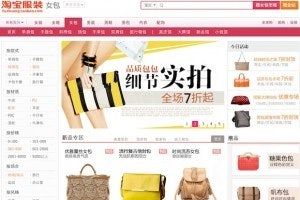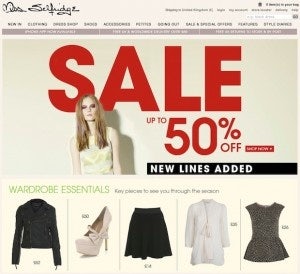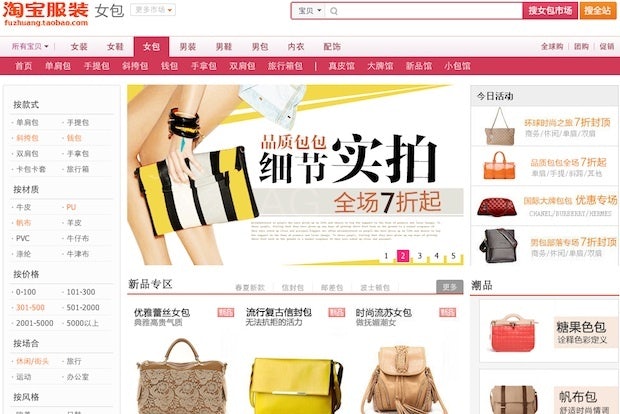China Expected To Become World's Largest Luxury E-Commerce Market By 2015#

China's luxury e-commerce market may still be young, but it's anything but boring. Following record investment in 2011 and a raft of new entrants joining the market, 2012 has seen the earliest signs of an industry shakeout and announcements by the likes of Net-A-Porter and Neiman Marcus, as well as designers like Alexander Wang, that they're ready to launch e-commerce options in China. Considering the country's overall online retail market hit US$121 billion in sales last year, according to Barclays Capital, a 66 percent increase over 2010, and China is expected to become the world's largest luxury retail as well as luxury e-commerce market by 2015, it's easy to see why global and home-grown companies continue to pile in.
Earlier this year, Jing Daily referenced a study by iResearch that found China's luxury e-commerce market hit 10.73 billion yuan (US$1.59 billion) in 2011 -- a nearly 70 percent leap over 2010's 6.36 billion yuan -- and will surge to 37.24 billion yuan (US$5.9 billion) by 2015. But a new report by Chinese online retail powerhouse Taobao holds that the luxury e-commerce market may be far larger than previously thought.
According to Taobao's study, high-end e-commerce purchases in China for a full spectrum of luxury goods, including health and beauty products, surpassed 15 billion yuan (US$2.4 billion) in 2011, a 100 percent surge year-over-year. In 2012, the study projects, the luxury e-commerce market in China should exceed 20 billion yuan. The study notes that Taobao users who regularly purchase high-end goods from overseas now number 2.3 million, of which 70 percent are female. Among the motivations found by Taobao for purchasing luxury goods from overseas sellers were lower prices (due to a rising yuan and the stiff import and luxury taxes imposed on items found at physical stores in China) and more options.
Taobao's study adds that, excluding high-volume purchases like housing and automobiles, annual turnover of daily-use luxury goods like luggage, apparel and watches in 2011 surpassed 15 billion yuan, of which Taobao's market share totaled 148 million yuan (US$23 million). The report points out that Taobao recorded a spike in sales of high-priced items last year, including 29,800 yuan (US$4,709) Cartier watches and 26,000 yuan ($4,109) Chanel bags. According to the study, the most expensive luxury item listed this past year by a Taobao seller outside of mainland China, a 388,000 yuan ($61,316) limited-edition Hermes handbag, was "sold immediately."
In terms of the countries from which Taobao luxury sellers operate outside of the Chinese Mainland, two-thirds of sales originate from the United States, Japan and Hong Kong. In addition to the Greater China region, the study notes that a growing number of sellers are located in Canada, France, Germany and Italy, with Germany rising to four percent of total overseas sales last year.

For brands like Louis Vuitton, Gucci, Prada and Chanel, the Taobao report finds Chinese consumers can expect "discounts" of around 20 percent compared to brick-and-mortar stores within China, while shoppers can occasionally find mass-market brands, such as Coach and Calvin Klein, 50 percent cheaper online. Chinese consumers have also been drawn to online shopping to find brands that have yet to enter the China market, including Topshop (which recently became available at Harvey Nichols in Hong Kong), ASOS and Miss Selfridge.
In terms of the cities from which the actual shoppers purchasing luxury items from overseas hail, most live in Shanghai, Beijing and Hangzhou. 80 percent of luxury online shoppers hold an undergraduate degree, with those holding graduate degrees making up 13.4 percent and growing. This fits with other studies that noted most high-end e-commerce devotees are urban white-collar workers with relatively high incomes (for China) and a high brand awareness level.
Unlike China's brick-and-mortar luxury market -- which is largely driven by male-led "gifting" -- the future of China's high-end e-commerce market is very much female. (Though this demographic is making up a growing proportion of buyers at physical stores in the country as well.) The ratio of male to female shoppers out of the estimated 2.3 million Taobao shoppers in China currently sits at 30 percent to 70 percent, though among "active shoppers," the ratio of male to female is 20 percent to 80 percent -- this, the study notes, indicates that to Chinese women, e-commerce is "the platform of choice for their favorite foreign products."
